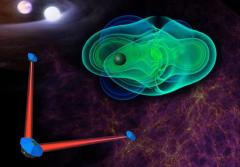Good news for Dutch space research and space sector
The European Space Agency ESA has given the green light for the development of three scientific space missions in which Dutch science and the Dutch space sector are playing an important role. These are the gravitational wave detector LISA, exoplanet telescope PLATO, and XARM, a recovery mission for the space telescope Hitomi that was lost in 2016 just a few weeks after its launch.

LISA is a space detector that will be able to detect gravitational waves with far larger wavelengths than the waves measured so far on Earth. After its launch in 2034, LISA will make a new unexplored area of gravitational waves visible. An international group of scientists and institutes – which from the Netherlands includes Gijs Nelemans (Radboud University), Elena Maria Rossi (Leiden Observatory), the Dutch research institutes SRON, Nikhef, TNO and the research school NOVA, proposed LISA earlier this year as a gravitational wave mission of the European Space Agency ESA. On behalf of the Dutch institutes, SRON informed ESA in a letter of endorsement sent at the start of March that, in principle, they wanted to contribute to the development of the space instrument. SRON and Nikhef will work together on a phase meter, which can establish minimum changes in distance between the satellites within the space installation. TNO has already developed precise opto-mechanical components that are crucial for precisely directing the laser beams transmitted between the satellites. See also ESA’s press release: http://www.esa.int/Our_Activities/Space_Science/Gravitational_wave_mission_selected_planet-hunting_mission_moves_forward
ESA has also given the green light for the construction phase of the PLATO mission. From 2026 onwards, the PLATO space telescope will search for exoplanets among thousands of stars by observing dips in the intensity of the starlight. SRON Netherlands Institute for Space Research will test and characterize 8 of the 26 cameras for PLATO. In addition, SRON will develop models that can extract information from PLATO’s data about the atmosphere and clouds of such exoplanets. For further information see the separate SRON news release: https://www.sron.nl/news/4725-groen-licht-voor-maken-exoplaneet-telescoop-plato
ESA has also decided to make a contribution to the Japanese/American satellite XARM (the X-ray Astronomy Recovery Mission). This mission will compensate the loss of the Japanese X-ray telescope Hitomi (previously called ASTRO-H). Just like Hitomi, XARM will make X-ray observations of unprecedented accuracy. SRON made a vital filter wheel for the Hitomi satellite. The ESA contribution to XARM also means a green light for a Dutch/ Swiss contribution. This will once again consist of a filter wheel with in addition to this X-ray sources. Further information about the lost satellite Hitomi (the new XARM page is under construction): https://www.sron.nl/news/4347-japan-launches-new-space-telescope
ESA bezegelt drie wetenschappelijke ruimtemissies
Goed nieuws Nederlands ruimteonderzoek en ruimtevaartsector
De Europese ruimtevaartorganisatie ESA heeft dinsdag groen licht gegeven voor de ontwikkeling van drie wetenschappelijke ruimtemissies waar de Nederlandse wetenschap en ruimtevaartsector een belangrijke rol in spelen. Het gaat om de zwaartekrachtsgolvendetector LISA, exoplaneet-telescoop PLATO en om XARM, een herstelmissie voor de ruimtetelescoop Hitomi die in 2016 enige tijd na de lancering verloren ging. (English added asap)

LISA is een ruimte-detector die zwaartekrachtgolven met nog veel grotere golflengtes zal kunnen detecteren, dan op aarde tot dusver is gedaan. Dit zal na lancering in 2034 een nieuw onontgonnen gebied van zwaartekrachtsgolven zichtbaar maken. Een internationale groep wetenschappers en instituten onder wie uit Nederland Gijs Nelemans (Radboud Universiteit), Elena Maria Rossi (Sterrewacht Leiden), de Nederlandse onderzoeksinstituten SRON, Nikhef, TNO en de onderzoekschool NOVA, hebben begin dit jaar LISA voorgesteld als zwaartekrachtsgolvenmissie van de Europese ruimtevaartorganisatie ESA. SRON heeft ESA begin maart namens de Nederlandse instituten in een letter of endorsement laten weten dat zij in principe willen bijdragen aan de ontwikkeling van het ruimte-instrument. SRON en Nikhef werken gezamenlijk aan een fasemeter, die minieme afstandsverandering tussen de satellieten binnen de ruimte-installatie kan vaststellen. TNO ontwikkelde al precisie opto-mechanische onderdelen, essentieel om laserlicht tussen de satellieten in de installatie goed te richten.
ESA heeft ook groen licht gegeven voor de bouwfase van de PLATO-missie. PLATO wordt een telescoop in de ruimte die vanaf 2026 bij duizenden sterren op zoek gaat naar exoplaneten door te speuren naar dipjes in de intensiteit van het sterrenlicht. SRON Netherlands Institute for Space Research gaat 8 van de 26 camera’s van PLATO testen en karakteriseren. Daarnaast gaat SRON modellen ontwikkelen die uit PLATO’s gegevens informatie kunnen winnen over de atmosferen en wolken op zulke exoplaneten. Zie voor meer informatie het aparte SRON-bericht: https://www.sron.nl/news/4725-groen-licht-voor-maken-exoplaneet-telescoop-plato
ESA heeft voorts besloten tot een bijdrage aan de Japans/Amerikaanse satelliet XARM (de X-ray Astronomy Recovery Mission). Deze missie compenseert het verlies van de Japanse röntgentelescoop Hitomi (eerder ASTRO-H genoemd). Net als Hitomi zal XARM ongekend nauwkeurigere röntgenwaarnemingen doen. SRON maakte destijds voor deze missie een essentieel filterwiel. De ESA-bijdrage betekent ook groen licht voor een Nederlands/Zwitserse bijdrage. Die bestaat wederom uit een filterwiel, met daarnaast röntgenbronnen. Meer informatie over de verloren Hitomi (aan de pagina van vervanger XARM wordt gewerkt): https://www.sron.nl/news/4347-japan-launches-new-space-telescope
ESA heeft zelf een persbericht uitgedaan naar aanleiding van de vergadering van de Science Programme Committee waarin deze drie besluiten zijn genomen: http://www.esa.int/Our_Activities/Space_Science/Gravitational_wave_mission_selected_planet-hunting_mission_moves_forward
Voor meer informatie en contactpersonen kunnen wij ons persbericht verstrekken voor zover niet ontvangen. 088 – 777 5893


